|
|
|
Sort Order |
|
|
|
Items / Page
|
|
|
|
|
|
|
| Srl | Item |
| 1 |
ID:
132579
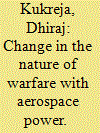

|
|
|
|
|
| Publication |
2014.
|
| Summary/Abstract |
There is nothing more difficult to carry out, nor more doubtful of success, nor more dangerous to handle, than to initiate a new order of things - Machiavelli
There has been a continuing transformation in the art and science of war ever since the aircraft was first used as a weapon of war, and then with the adoption of technological excellence. The use of the third dimension to enhance military capabilities had developed and settled during World War II. Gen Eisenhower put emphasis in his words when he stated, "The Normandy landings were based on a deep-seated faith in the power of the air force in overwhelming numbers to intervene in the land battle." Ever since that era, aviators, the world over, have been putting forth their case that air power should hold centre-stage in any war.
|
|
|
|
|
|
|
|
|
|
|
|
|
|
|
|
| 2 |
ID:
171204
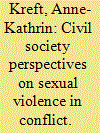

|
|
|
|
|
| Summary/Abstract |
In international policy circles, conflict-related sexual violence (CRSV) is commonly viewed as a weapon of war, a framing that researchers have criticized as overly simplistic. Feminist scholars in particular caution that the ‘weapon of war’ framing decontextualizes sexual violence in conflict from the structural factors of gender inequality that underpin its perpetration. In light of these tensions, how do politically relevant local actors perceive the nature and the origins of conflict-related sexual violence? Civil society organizations often actively confront conflict-related sexual violence on the ground. A better understanding of how their perceptions of this violence align or clash with the globally dominant ‘weapon of war’ narratives therefore has important policy implications. Interviews with representatives of Colombian women's organizations and victims' associations reveal that these civil society activists predominantly view conflict-related sexual violence as the result of patriarchal structures. The mobilized women perceive sexual violence as a very gendered violence that exists on a continuum extending through peace, the everyday and war, and which the presence of arms exacerbates. Strategic sexual violence, too, is understood to ultimately have its basis in patriarchal structures. The findings expose a disconnect between the globally dominant ‘weapon of war’ understanding that is decontextualized from structural factors and a local approach to CRSV that establishes clear linkages to societal gender inequality.
|
|
|
|
|
|
|
|
|
|
|
|
|
|
|
|
| 3 |
ID:
122402
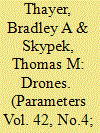

|
|
|
|
|
| Publication |
2012-13.
|
| Summary/Abstract |
The drone debate continues hot and heavy. Critical issues range
from the morality of targeting choices and concerns about unintended casualties and anti-Americanism to matters of legal and
bureaucratic oversight.1
These are pressing questions; the United States'
use of drones as a weapon of war is on the rise, and other countries are
interested in acquiring them.2
|
|
|
|
|
|
|
|
|
|
|
|
|
|
|
|
| 4 |
ID:
138944
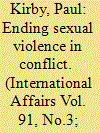

|
|
|
|
|
| Summary/Abstract |
During the past year, the UK Government has become the lead advocate for a perhaps surprising foreign policy goal: ending sexual violence in conflict. The participation of government representatives from more than 120 countries in a London Summit in June 2014 was the clearest manifestation of this project. This article offers an early assessment of the Preventing Sexual Violence Initiative (PSVI) and situates it within the history of global action against sexual and gender-based violence from UN Security Council Resolution 1325 onwards, with a particular focus on three key developments. First, the PSVI has embraced the already common understanding of rape as a ‘weapon of war’, and has stressed the importance of military training and accountability. This has exposed the tensions within global policy between a focus on all forms of sexual violence (including intimate partner violence in and out of conflict situations) on the one hand, and war zone activities on the other. Second, the Initiative has placed great emphasis on ending impunity, which implicates it in ongoing debates about the role of international and local justice as an effective response to atrocity. Third, men and boys have been foregrounded as ignored victims of sexual and gender-based violence. The PSVI has been crucial to that recognition, but faces significant challenges in operationalizing its commitment and in avoiding damage to existing programmes to end violence against women and girls. The success of the Initiative will depend on its ability to navigate these challenges in multiple arenas of global politics.
|
|
|
|
|
|
|
|
|
|
|
|
|
|
|
|
| 5 |
ID:
131812
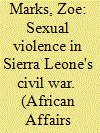

|
|
|
|
|
| Publication |
2014.
|
| Summary/Abstract |
Rape and sexual violence loom large in the study of civil war in Africa. Sierra Leone has been one of the most prominent cases for establishing rape as a 'weapon of war', yet little is known about how sexual violence was understood by commanders or combatants within the Revolutionary United Front (RUF). Mainstream analyses of armed groups and civil war rarely engage with gender dynamics, despite their centrality to war making, power, and violence; and research that does focus on sexual violence tends to overlook the complex internal dynamics of the groups responsible. This article examines the internal gender dynamics of the RUF from the perspective of male and female members in seeking to understand the perpetration of sexual violence. It shows that both formal and informal laws and power structures existed to regulate gender relations and control sexual behaviour within the group. It identifies four categories of women - non-wives, unprotected wives, protected wives, and senior women - and shows that women's interests and experiences of sexual violence were not homogeneous, but were instead shaped by their status within the group. In this way, sexual violence, examined in social context, provides an entry point for understanding how power, protection, and access to resources are brokered in rebellion.
|
|
|
|
|
|
|
|
|
|
|
|
|
|
|
|
|
|
|
|
|